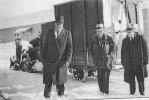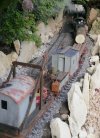For some reason I cannot reply to individual posts, so here goes. Don't worry Greg, I appreciate that this might seem an odd place to start my search but I just want to get an idea if these locos have similar voltage requirements to each other to kick along at a reasonable lick. The LED power lights on my old faithful TE and the 1:20'3 scale calibrated speedo' wagon (25 mph with the rodded, 15 mph for the geared when loaded) give me the impression they might do. I suppose I should have tested what voltage I was putting through the track to power them. Then again the voltage you put through a whole track and what you need with a fairly clean feed over a couple of short wires might be a bit different. I just need the confirmation of a baseline to work from. If not I need to have the ability, as you suggest, to have some handy leads built in to allow the fine tuning with extra cells.
Agreed, when you are looking at converting 12 locos you are going to need to try and standardize your control system to one that meets your needs and the demands of the operation perimeters chosen,. Mine hopefully will remain fairly simple. By virtue of my perceived primary need for good support and simplicity in set up and operation (viz any of my previous crie du coeurs here and elsewhere) then my options are probably going to be limited to established UK suppliers at this scale.
Unless there are some convincing arguments to the contrary I will probably go for one of the "plug and play" solutions from Fosworks. They can offer both DC & DCC and they all operate from a small handheld TX's. Yes, that 2 stick, or worse still model car wheel and trigger is a weird default, probably from the 16 mm world, which I also inhabit. Foswork's Omni TX's can handle single or multiple assigned locos, even synchronizing locos' speed when double heading from one TX (apparently its to do with the ESC). I'm going to have a chat with them to see if they can persuade me of the benefits of their DCC options. But ultimately I am looking for a pre-wired pretty well standardized "plug and play package". Yes, there are always the exceptions, I've noted 3 already here, that may require a different approach, but that will more be dictated by packaging constraints.
Trailing "battery cars" are not something I want to get into if possible. Economical but they would cause some operational issues and strange consists. However, I can see one instance where that approach would be a benefit - the little Porter. A string of mountain ore/coal cars are on order for that one now, thanks for the idea Mike. There is also the matter that on 3 of the locos I would like to use the 3 Sierra sound cards I acquired about a year ago (thanks again Mike), Those need a means of converting PWM to DC and a voltage regulator added if they are going to live in this brave new battery powered world.
The need for sound is a given in this project. Whether I want to go beyond one of the generic sound cards to one of the flashy DCC loco specific ones, and all the additional cost that may entail is an area I'm undecided on.
I'm well aware I need to keep the amps drawn firmly in sight. However my experiences so far with my Accuraft K-27 and GRS steam outline Manning Wardle seem to indicate that tried and tested NiMH packs offer sufficient energy density for the power draw and duration of operation I want, with sound, lights and bells going. However, and thanks for this Jimmy, Lipo could be an option to consider as it seems to offer more compact/efficient packaging of the energy to shift these beasties and their not inconsiderable consists on my fairly level and not too tightly wound curves.
I really need an editor for these posts

Max


